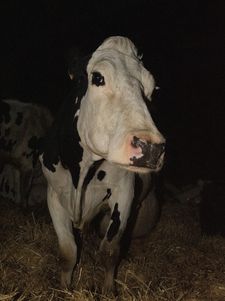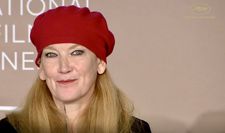 |
| Andrea Arnold: 'It was when I moved to London that I felt separated from the free relationship I had with nature as a child' Photo: Cannes Film Festival/Daniele Venturelli/Getty Images) |
Arnold delves into what happens to livestock in the dairy industry. There are few holds barred in the process. “It’s a hard film to explain,” she says but tries her best. “It took me back to my relationship with nature as a kid. I think that is where it started. I had this very free relationship with nature as a child, partly because I had young parents who mostly were not there and I was left to my own devices.”
 |
| Andrea Arnold on her 'star' Luma: 'I love it when she looks directly the camera. When she looked at us I felt she was really looking' Photo: Courtesy of Cannes Film Festival |
She started work on the project some eight years ago. “It was a slow burn thing that seemed to go on for a long time. We shot over three or four years and there was a lot of stopping and starting,” she recalled. At the same time Arnold was editing the second season of Big Little Lies but thought that Cow might be an interesting diversion. “I thought it would be a place I would check in at the end of the day but I never had time,” she said. In the interim her three editors on Cow started work on pruning the 200 or so hours of footage.
She found her “star” Luma, a Holstein-Friesian, after a lengthy search among the dairy herds in farms around the M25. “When you look at cows you do not see them as individuals. They all have characters and I was told that Luma was feisty and she had a distinctive look. I love it when she looks directly the camera. When she looked at us I felt she was really looking.”
Arnold cites a further motivation as a study by a group of scientists whose research suggested that animals can be conscious and aware to the same degree as humans. She wanted her film to remind viewers about how “our relationship with the millions of non-human lives we use is very much part of our existence”.
She invites the viewer to imagine what Luma is thinking or feeling, to look out through her black eyes as she stares into the camera lens, or to feel the anguish in her plaintive mooing as her latest calf is taken away. Her birth is shown in fairly graphic detail in the film’s opening scene - a debut to remember. Arnold gave an assurance that nothing was faked or manipulated during the filming.
“I made it in a way that people would find different kind of responses. You should come out of it with whatever you want to take away,” she said of what is her first documentary.
 |
| Andrea Arnold: 'I made it in a way that people would find different kind of responses' Photo: Courtesy of Cannes Film Festival |
She conceded that Cow (screened in the Cannes Premiere section) had changed during the editing process because she likes to “embrace the changes and obstacles that the shoot can bring.” She cited the sculptor Giacometti who could reach the thing he had in mind. “I think that is true for anyone. You have an idea which is very pure, and then you face the reality. I try to introduce a bit of chaos, certainly in my dramas. I do not like to go into a scene knowing exactly how it is going to be.”
Over the years she has become a Cannes junkie. “I love it here. It's is a place where art film is at its heart. I appreciate and am grateful for that. It was strange going from lockdown to all of this. It is quite emotional to see people together. It feels like a big experience after what we have been through, and are still going through. It makes it even more poignant.”
As serendipity would have it today 13 July is National Cow Appreciation Day, which Arnold fully intends to celebrate.





















